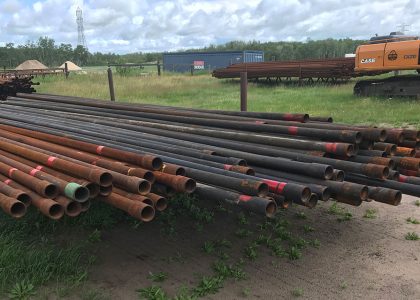Why Torque Correlation Matters for Screw Pile Design
In screw pile engineering, torque correlation is a proven method for estimating the axial load capacity of a pile based on its installation torque. This method is widely accepted under ICC-ES AC358 and has been validated in both field experience and laboratory research.
The relationship is simple: Qult=Kt×TQ_\text{ult} = K_t \times TQult=Kt×T
- TTT = average sustained installation torque over the final ~0.9–1.0 m (3 ft) of embedment
- KtK_tKt = torque correlation factor, which depends on shaft size and geometry
Typical AC358 default KtK_tKt values (imperial units):
- 1.5–1.75″ square shaft → 10 ft⁻¹
- 2.875″ OD round shaft → 9 ft⁻¹
- 3.0″ OD round shaft → 8 ft⁻¹
- 3.5″ OD round shaft → 7 ft⁻¹
Best Practices for Measuring Torque
- Use calibrated torque measurement (in-line torque cell or a verified pressure-torque curve)
- Record torque vs. depth and average the last 3 ft in the bearing layer
- Maintain ≥85% pitch advance per revolution to confirm the helix is cutting, not augering
- Ignore short-lived spikes caused by obstructions or dense seams
Soil Strength and Soil Type Effects
- Cohesive clays: Torque correlates well to undrained shear strength (sus_usu), making it reliable for capacity estimation.
- Granular soils: Torque relates to frictional resistance, but variability in density and particle size can reduce reliability — load testing is recommended.
- Expansive clays: High swell potential can cause seasonal heave and downdrag forces, so depth below the active zone is critical.
Red River Valley Soil Conditions
The Red River Valley in Manitoba is the former bed of Glacial Lake Agassiz.
Typical profile:
- Fill/topsoil
- Silty clay (“gumbo”) — expansive, often fissured, with high montmorillonite content
- Dense glacial till and, at depth, bedrock
Engineering considerations:
- Seasonal moisture changes can penetrate 3–4 m (10–12 ft), so helix embedment should extend below this active zone
- Target bearing layers in uniform clay or dense till
- Fissured clays can give high torque readings without long-term strength — verify with load testing where possible
Practical Example for Manitoba
For a 2.875″ OD round shaft (default KtK_tKt = 9 ft⁻¹) and a target ultimate capacity of 60 kips: T=60,0009≈6,670 ft\cdotplbT = \frac{60{,}000}{9} \approx 6{,}670 \ \text{ft·lb}T=960,000≈6,670 ft\cdotplb
This torque should be the sustained average over the last 3 ft in the intended bearing stratum.
Key Takeaways for Installers in the Valley
- Follow AC358 defaults or use site-specific load tests for more accurate KtK_tKt
- Embed below the active zone to avoid seasonal movement impacts
- Keep thorough torque logs for each pile installed
- In variable soils, proof test a sample of piles to confirm capacity
📞 Need Expert Screw Pile Design in Manitoba? Call: 204-388-9037
We specialize in code-compliant screw pile installation for the unique soils of the Red River Valley.
Contact us for engineered designs, torque verification, and geotechnical insight to make sure your foundations last.


